What happens when your customers demand instant, personalized responses, but you can’t deliver? With 70% of customers expecting immediate replies and only 40% of businesses meeting that need, the stakes are high. Every delayed response or generic interaction risks frustration, trust, loyalty, and revenue.
Consider this: An online retailer losing a high-value customer during peak shopping due to slow service, or a B2B supplier failing to provide timely updates, straining client relationships. How much trust is lost in these moments? How many opportunities slip away due to outdated systems and inefficient processes? These inefficiencies frustrate customers and weaken business competitiveness.
Meanwhile, decision-makers face relentless pressure from stakeholders to innovate, deliver results, and stay ahead of competitors. And the momentum is clear, generative AI in customer service alone is projected to surge to $4,535 million USD by 2034, signaling not just a trend but a strategic imperative.
Generative AI offers the answer. By automating intelligent responses, learning from interactions, and anticipating customer needs, businesses achieve 50% faster response times, 35% higher satisfaction, and improved scalability.
This article explores the potential of Generative AI: what it is, why it matters, how it transforms industries, real success stories, future trends, and strategies for leadership.
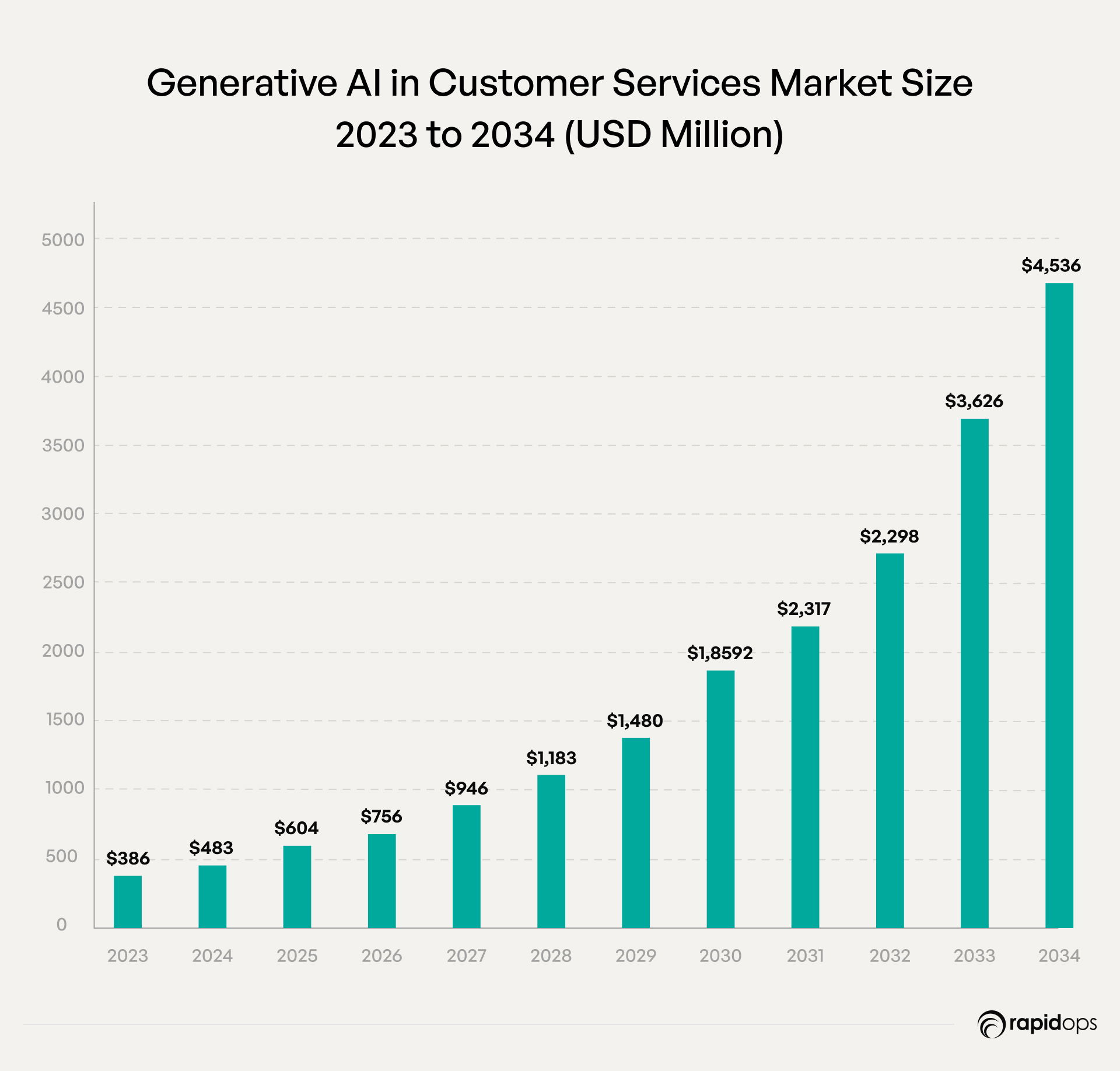
What is Generative AI, and Why Does It Matter?
What is Generative AI
Generative AI in customer service is a key enabler of operational efficiency and customer satisfaction. Unlike traditional AI, which is limited to predefined responses, generative AI leverages machine learning to analyze customer data, understand context, and deliver tailored, human-like interactions. This adaptability allows businesses to anticipate customer needs, resolve issues in real time, and deliver personalized service at scale. By aligning with shifting customer expectations, generative AI helps organizations improve service quality, drive customer loyalty, and achieve long-term competitive advantage.
How Generative AI Works in Customer Service
Generative AI operates through a conceptual framework that allows it to go beyond rule-based automation. Its functionality is rooted in three core processes:
- Pattern Recognition from Data: The AI model learns from extensive datasets, including customer conversations, service records, and FAQs, identifying trends and patterns that inform its decision-making.
- Contextual Understanding: Generative AI processes the specific nuances of each customer interaction, such as tone, intent, and history, ensuring its responses are both relevant and empathetic.
- Dynamic Response Creation: Instead of selecting a predefined response, generative AI constructs new, tailored outputs in real time. This adaptability ensures responses remain aligned with the unique demands of each query.
How Generative AI Transforms Customer Service
Customer service is no longer just about answering questions, it’s about delivering seamless, personalized, and efficient experiences that foster loyalty and drive growth. Generative AI transforms this process by redefining how businesses interact with their customers. Here’s how:
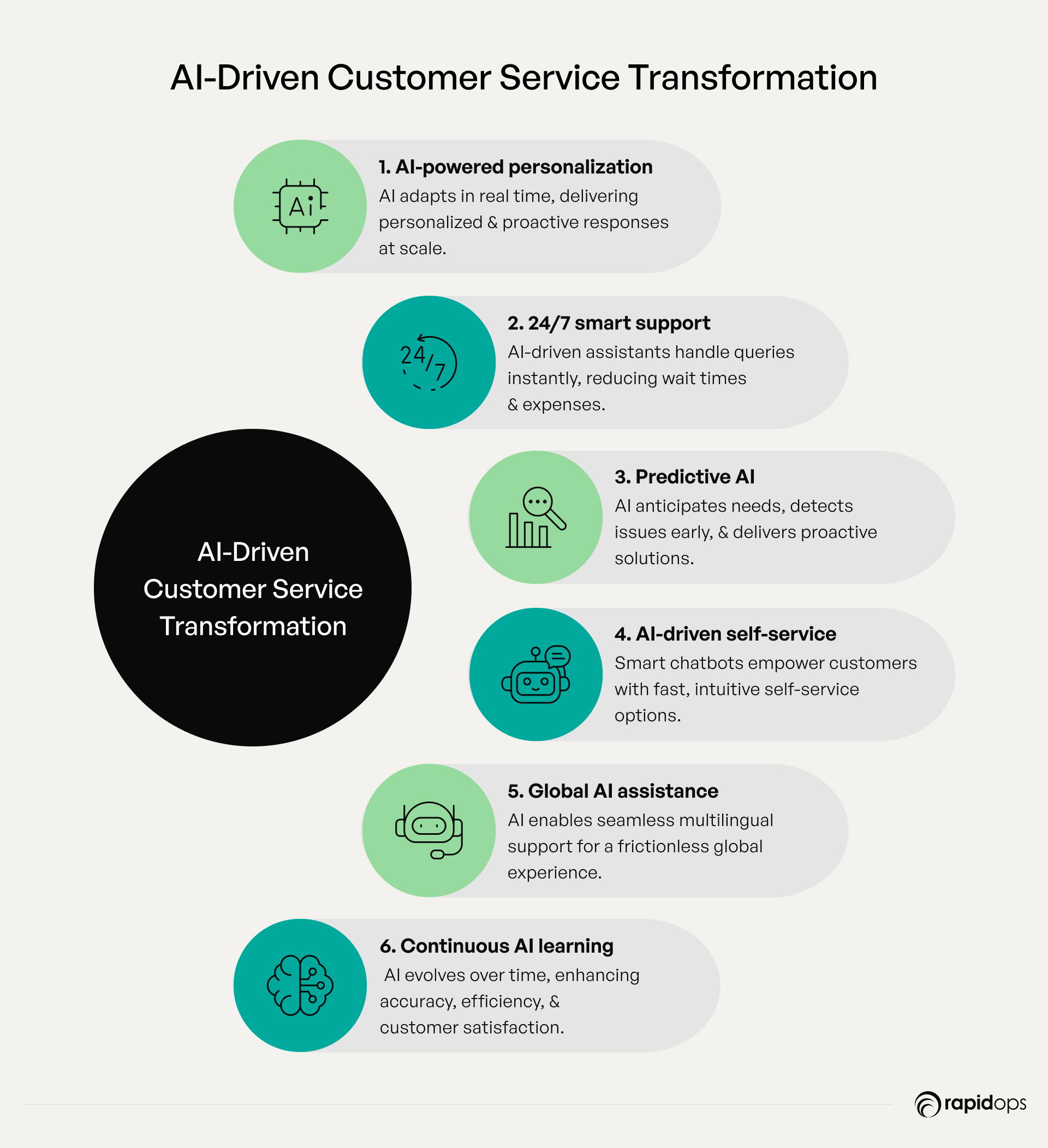
1. Personalized Customer Interactions at Scale
Delivering personalized experiences to millions of customers is seamless with generative AI in customer service. By leveraging advanced algorithms, it analyzes individual behaviors, preferences, and past interactions to craft contextually relevant, human-like responses in real time. This ensures customers feel uniquely valued and understood.
A study by McKinsey found that 71% of customers expect personalization, and businesses implementing it effectively see 20% higher loyalty rates.
Generative AI further enables tailored product recommendations, proactive assistance, and seamless follow-ups redefining customer service as a loyalty driver. It scales these interactions efficiently, bridging the gap between customer expectations and operational capacity.
2. 24/7 Availability Without Increased Costs
Imagine a customer needing help at midnight or during peak sales events, moments when traditional support teams are stretched thin. For 80% of customers who expect immediate responses (Forrester), delays can lead to frustration and lost trust.
Generative AI ensures round-the-clock availability, providing real-time responses regardless of time zones or holidays. By automating up to 80% of routine inquiries, such as order tracking or account updates, it guarantees prompt service while reducing the strain on human agents. This allows businesses to reallocate resources to more complex issues, enhancing overall efficiency.
The result? Customers feel valued with instant support, and businesses maintain exceptional service without the need for additional staff. Generative AI bridges the gap between high customer expectations and cost-effective scalability, setting the foundation for stronger relationships and long-term loyalty.
3. Proactive Customer Support
Imagine a customer being notified of a potential delivery delay before they even ask. Generative AI in customer service enables businesses to identify and address issues proactively by analyzing data trends and historical patterns. It empowers timely actions, such as offering replacements or alternative solutions, preventing frustration before it arises.
Proactive support isn’t just a feature; it’s essential. Studies reveal that 86% of customers are willing to pay more for a better experience (PwC). Addressing issues before they escalate builds trust, demonstrates care, and fosters loyalty.
Generative AI transforms support from reactive problem-solving to anticipating customer needs. This evolution increases satisfaction by 30%, reduces complaints, and positions businesses as leaders in customer-centric innovation.
4. Intelligent and Intuitive Self-Service Options
Generative AI enhances self-service by integrating intelligent chatbots and adaptive knowledge bases that deliver real-time, personalized guidance. Unlike traditional systems, it dynamically interprets queries, analyzes customer context, and provides tailored solutions. For example, it can guide users through troubleshooting steps or product setup, adapting responses based on customer behavior.
Research by Forrester highlights that 56% of customers abandon self-service tools when they fail to meet expectations. Generative AI addresses this by continuously learning from interactions, refining its ability to resolve complex issues accurately and efficiently.
By automating repetitive queries and evolving with user feedback, generative AI ensures self-service tools remain intuitive, responsive, and aligned with customer needs, transforming how businesses engage with their audience.
5. Real-Time Multilingual Support for a Global Audience
Language barriers have long been a challenge for businesses operating in diverse markets, often leading to miscommunication and dissatisfaction. Generative AI for customer service addresses this by offering real-time multilingual capabilities, enabling seamless communication in over 100 languages. Through advanced Natural Language Processing (NLP) models, generative AI understands, translates, and generates contextually accurate responses, ensuring every interaction feels native and personalized.
For example, generative AI can simultaneously handle queries from customers speaking Mandarin, French, or Spanish, without requiring additional human translation support. This capability not only reduces delays but also enhances customer trust by delivering culturally nuanced and relevant communication.
By eliminating the need for large multilingual support teams, generative AI in customer service allows businesses to scale globally without increasing operational costs.
6. Continuous Improvement Through Learning
What if your customer service improved with every interaction? Unlike static systems, generative AI in customer service evolves continuously, learning from interactions and adapting to customer behaviors over time. This ensures faster resolutions, fewer escalations, and increasingly personalized responses—consistently exceeding expectations.
Using advanced machine learning algorithms, generative AI processes vast data sets to identify patterns and refine responses. An AI system managing thousands of queries daily can quickly adapt, addressing recurring issues more effectively.
Businesses leveraging generative AI report a 35% increase in customer satisfaction (MIT Technology Review). By evolving with every interaction, generative AI builds trust, fosters loyalty, and equips businesses to thrive in a competitive, digital-first world.
What Are the Benefits of Generative AI for Customer Service?
Generative AI offers powerful benefits for customer service, enabling faster, smarter, and more personalized support. Here are the key impacts driving this transformation.
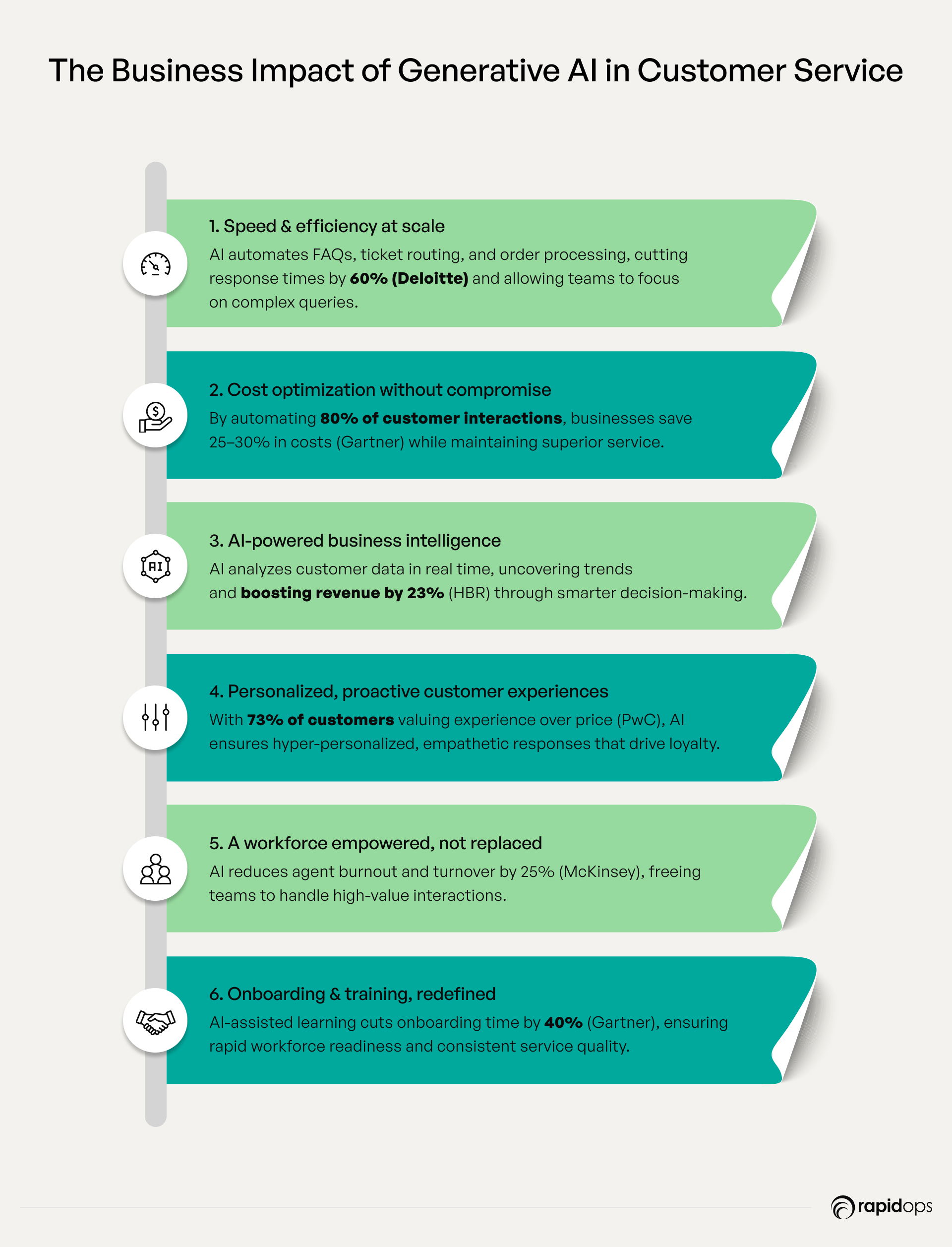
Enhanced Efficiency
Generative AI in customer service automates repetitive tasks like responding to FAQs, processing orders, and routing tickets, significantly reducing response times. AI-powered solutions allow customer service teams to focus on resolving complex inquiries requiring human empathy and expertise.
According to Deloitte, automation powered by AI reduces processing times by up to 60%, enabling businesses to meet customer demands seamlessly while boosting productivity.
Cost-Effectiveness
By automating up to 80% of customer interactions, generative AI reduces the need for extensive staffing, leading to significant cost savings. Businesses can provide round-the-clock support without additional expenses, achieving a 25–30% reduction in costs while maintaining high-quality interactions (Gartner). This financial efficiency supports strategic growth initiatives and resource optimization.
Scalability
Generative AI ensures seamless scalability, particularly during peak demand periods like holiday sales or new product launches. AI solutions can handle thousands of interactions simultaneously, maintaining consistent service quality without increasing staffing costs. This adaptability, driven by Generative AI in customer service, allows businesses to effectively respond to market fluctuations and deliver exceptional experiences.
Actionable Insights
Generative AI analyzes vast customer data, uncovering trends, preferences, and recurring pain points to inform strategic decisions. AI-driven platforms identify dissatisfaction trends in real time, empowering businesses to optimize strategies and personalize customer journeys. Companies leveraging these insights achieve 23% higher revenue growth (Harvard Business Review), gaining a competitive edge in their markets.
Improved Customer Satisfaction
Generative AI creates hyper-personalized customer experiences by tailoring responses to individual needs and proactively addressing issues. Research from PwC reveals that 73% of customers prioritize experience over price when choosing a brand. AI-driven customer service builds trust, loyalty, and retention by delivering empathetic responses and proactive solutions, strengthening businesses' market positions.
Reduced Agent Burnout
Generative AI alleviates agent burnout by automating repetitive and mundane tasks, such as processing refunds or tracking orders. By handling up to 80% of routine inquiries (McKinsey), AI enables agents to focus on meaningful, high-value interactions requiring creativity and empathy. This reduces stress, improves job satisfaction, and leads to a 25% reduction in turnover rates, ensuring a motivated workforce that enhances customer experiences.
Faster Onboarding and Training
AI-powered systems accelerate onboarding and training by providing real-time guidance, sentiment analysis, and suggested responses during live interactions. New hires can achieve proficiency faster, reducing average onboarding time by up to 40% (Gartner). This streamlined process minimizes downtime, maintains service quality, and ensures businesses are prepared to scale efficiently during peak demand periods.
Integrating Generative AI in customer service transforms efficiency, personalizes interactions, and elevates customer satisfaction driving innovation, growth, and a strong competitive edge for the future.
What Technologies Are Behind Generative AI in Customer Service?
Generative AI is revolutionizing customer service by addressing the increasing demand for real-time, personalized support. By leveraging cutting-edge technologies, it creates seamless interactions, enhances efficiency, and elevates customer satisfaction. Below, we explore the core technologies driving Generative AI and their transformative impact on customer service.
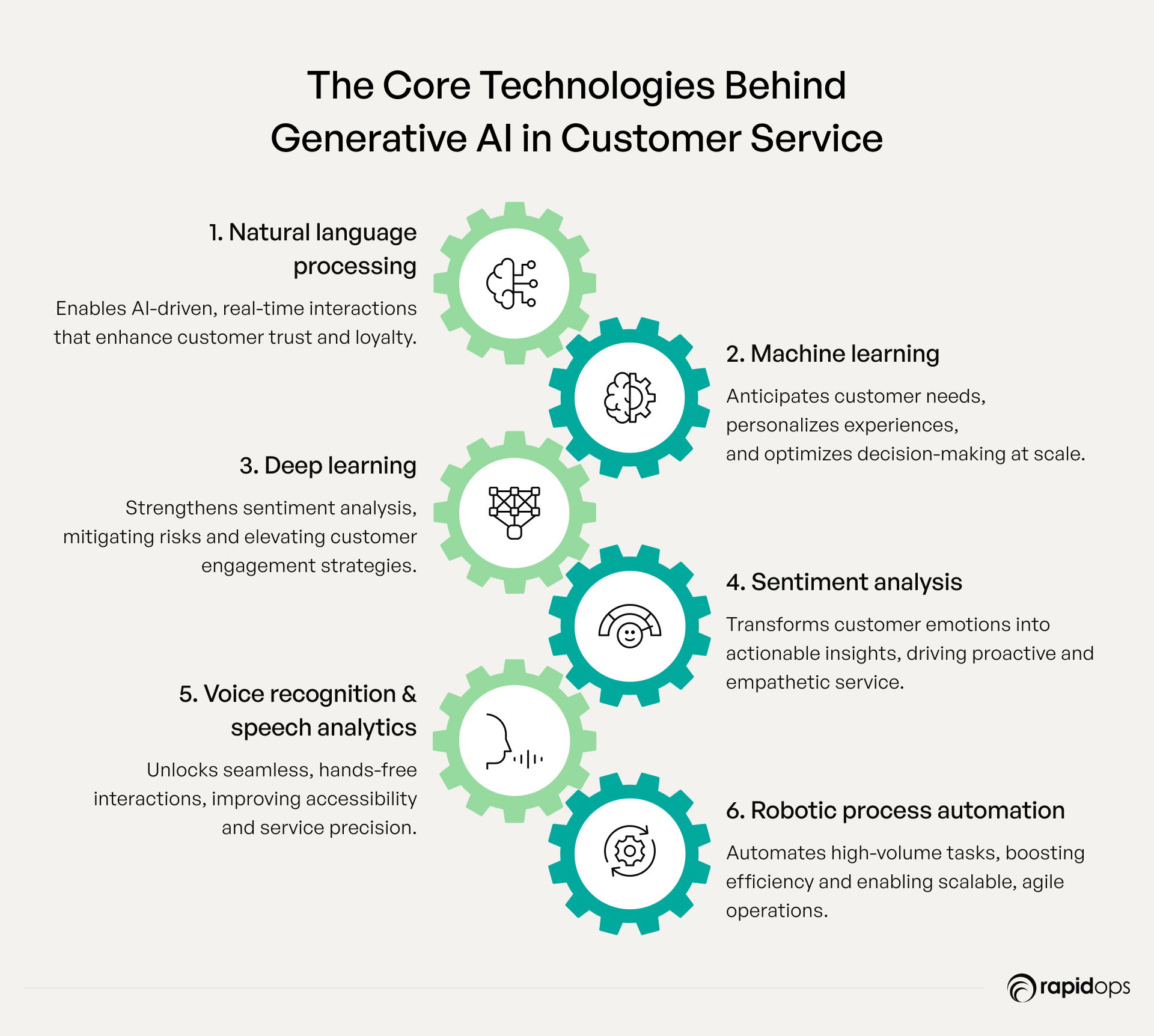
I. Natural Language Processing (NLP)
NLP enables AI to interpret, understand, and respond to human language naturally and accurately. By analyzing context, tone, and intent, it ensures that every customer interaction feels intuitive, empathetic, and personalized.
How It Elevates Customer Service
NLP-powered systems enable chatbots and virtual assistants to mimic human-like conversations, providing instant, accurate responses. These interactions not only resolve customer issues faster but also create a sense of being understood, fostering stronger emotional connections with customers.
- Improved satisfaction: Real-time, context-aware responses build trust and enhance customer experiences.
- Cost efficiency: Businesses reduce support costs by 40% while achieving 50% faster response times (Gartner).
Example in Action
Imagine a customer querying a chatbot about a delayed package. Instead of a generic response, the bot says:
"Your package is delayed due to weather conditions but is expected tomorrow. Would you like us to notify you if there’s another update?"
This level of understanding and proactive communication strengthens customer loyalty.
II. Machine Learning (ML)
ML empowers AI systems to learn from historical data and customer interactions, enabling them to predict behaviors, anticipate needs, and deliver highly personalized solutions at scale.
How It Elevates Customer Service
By continuously analyzing customer data, ML enhances the ability of AI systems to adapt and improve. This leads to personalized recommendations, streamlined workflows, and proactive problem-solving, all of which make customer interactions smoother and more engaging.
- Customer retention: ML-based systems analyze patterns to identify potential churn risks and proactively address them.
- Operational efficiency: Automating routine queries and providing predictive insights reduce manual interventions.
Example in Action
A retail company’s ML-driven recommendation engine identifies a customer's preference for eco-friendly products. Based on their browsing history, it suggests sustainable alternatives during checkout, increasing cross-sell opportunities while aligning with customer values.
III. Deep Learning (DL)
Deep Learning enables AI to process complex datasets and identify intricate patterns. By simulating human decision-making, it allows AI systems to tackle nuanced customer queries and deliver highly contextualized solutions.
How It Elevates Customer Service
Deep Learning enhances sentiment analysis and emotional intelligence in AI systems. It ensures that customer frustrations are detected early and appropriately addressed, preventing escalations and preserving relationships.
- Minimized churn: Early detection of negative emotions helps businesses intervene before dissatisfaction escalates.
- Enhanced retention: Personalized and empathetic interactions increase customer loyalty.
Example in Action
A customer frustrated with repeated delays says:
"This is unacceptable! I’ve been waiting for days."
A DL-powered system detects their tone and immediately escalates the issue to a senior agent who resolves the problem personally, ensuring a positive outcome.
IV. Sentiment Analysis
Sentiment Analysis, a critical subset of NLP, identifies emotional cues in customer communications. By understanding the customer’s mood, tone, and intent, it enables AI to deliver responses that are both empathetic and effective.
How It Elevates Customer Service
Sentiment Analysis transforms reactive service into proactive care. By addressing negative emotions in real-time, businesses can turn potentially harmful interactions into opportunities to build trust and loyalty.
- Stronger emotional connections: Proactive empathy fosters long-term relationships.
- Fewer complaints: Companies using sentiment analysis see a 25% reduction in complaints by resolving issues before they escalate.
Example in Action
When a customer tweets:
"I’ve been waiting forever for a response!"
A sentiment-aware system immediately prioritizes the issue, responding with:
"We’re deeply sorry for the delay. Let me expedite this for you right away."
This responsiveness not only satisfies the customer but also reinforces their trust in the brand.
V. Voice Recognition and Speech Analytics
Voice Recognition allows customers to interact hands-free with AI systems, while Speech Analytics deciphers tone and intent to deliver relevant, real-time solutions.
How It Elevates Customer Service
By enabling seamless voice interactions, these technologies make customer service more accessible, especially for individuals who prefer verbal communication. Speech Analytics adds an extra layer by identifying emotional cues, ensuring responses are both timely and appropriate.
- Broader accessibility: Voice-enabled AI caters to diverse customer needs and preferences.
- Reduced frustration: Faster resolutions minimize customer effort.
Example in Action
A customer asks a voice-enabled system:
"What’s the status of my return?"
The system responds instantly with:
"Your return has been processed, and the refund is on its way. Is there anything else I can help you with?"
This immediate and accurate interaction boosts customer confidence.
VI. Robotic Process Automation (RPA)
RPA automates repetitive and time-consuming tasks such as order tracking, returns processing, and data entry, freeing up human agents to focus on complex and high-value interactions.
How It Elevates Customer Service
RPA ensures consistency and speed in handling routine operations, reducing errors and improving overall efficiency. Customers benefit from faster service and fewer delays.
- Increased productivity: RPA streamlines workflows, improving process efficiency by 60% (McKinsey).
- Enhanced scalability: Automated systems can handle demand surges without impacting service quality.
Example in Action
When a customer initiates a return, RPA verifies eligibility, processes the request, and sends a confirmation email, all within minutes. This hassle-free process leaves a positive impression.
Generative AI enhances customer service by delivering seamless, personalized, and efficient experiences. Leveraging technologies like NLP, ML, DL, and RPA, transforms service delivery into a strategic advantage. For decision-makers, adopting generative AI in customer service is the key to redefining engagement and ensuring long-term success.
How Is Generative AI Driving Success in Real-World Customer Service?
Case Study 1: Harris Teeter – AI-Powered Personalized Customer Engagement
Harris Teeter, a leading grocery chain, sought to boost customer loyalty and streamline support during peak shopping periods, like holiday sales, without overburdening their human staff.
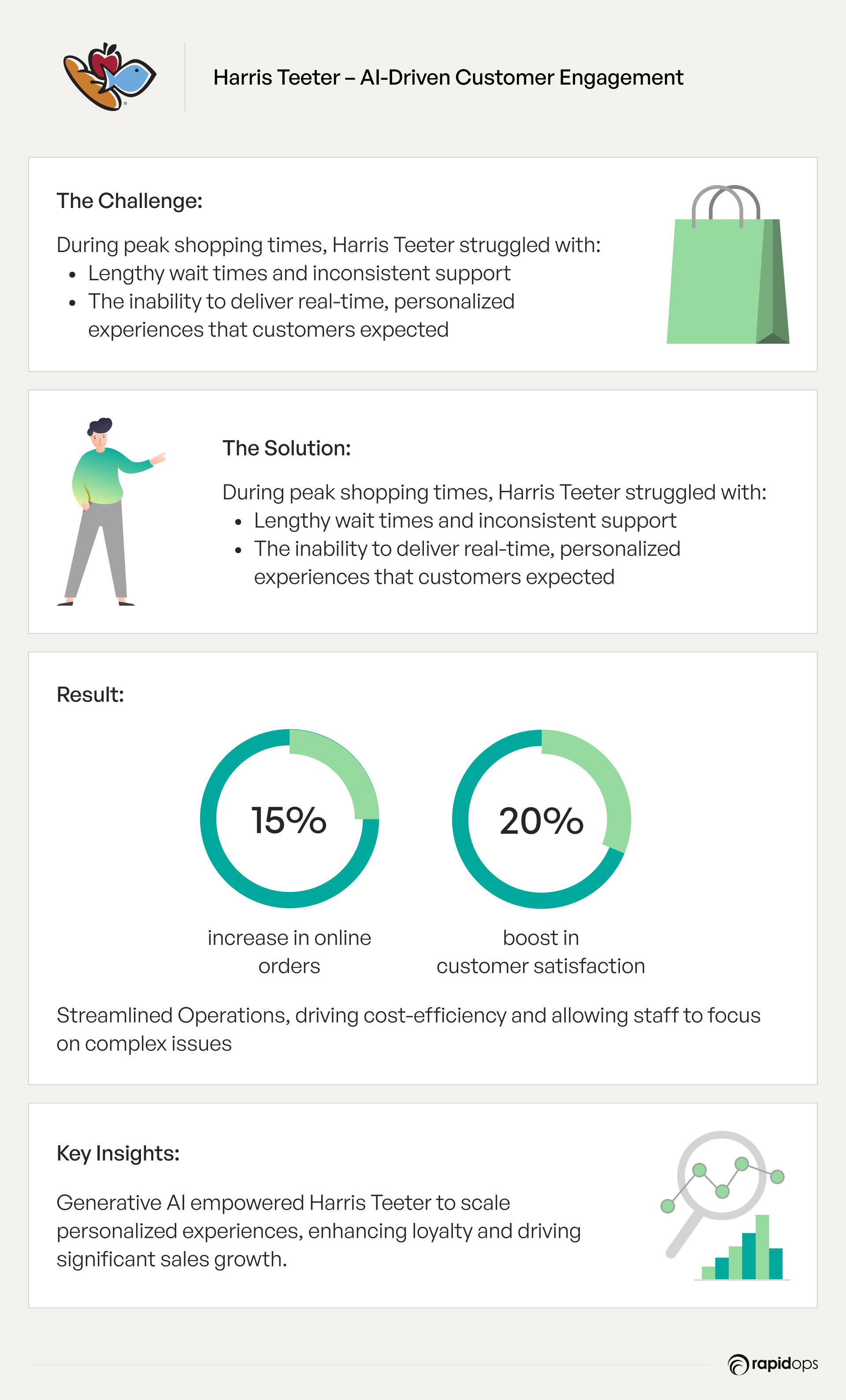
Problem
The company was struggling to maintain high-quality customer service during busy periods, facing long response times and inconsistent support across channels. Traditional support systems were unable to deliver the real-time, personalized experiences customers expected, leading to potential customer frustration and lost sales.
Solution
Harris Teeter implemented Generative AI to automate and personalize customer service. The AI-powered virtual assistant was integrated into its online platforms and mobile app, offering tailored product recommendations, order tracking, and personalized promotions based on customer behavior and preferences. AI-driven self-service and FAQ automation handled routine inquiries, such as item locations and loyalty point management, across web, mobile, and in-store kiosks, enabling a seamless customer experience.
Outcome
- 15% Increase in Online Orders: Personalized recommendations led to repeat purchases, boosting sales.
- 20% Higher Customer Satisfaction: Timely, context-aware responses significantly improved customer experience and loyalty.
- Operational Efficiency: AI reduced the workload for customer service agents, allowing them to focus on more complex tasks, resulting in a reduction in operational costs.
Key Takeaways
- Personalization at Scale: Generative AI drives loyalty and sales through scalable, personalized experiences.
- Automation of Routine Tasks: Automating FAQs and self-service reduces costs and boosts efficiency.
- Real-Time Engagement: Timely, relevant responses enhance customer satisfaction and loyalty.
Case Study 2: Siemens – AI-Enhanced Customer Support for Manufacturing Services
Siemens, a global manufacturing leader, aimed to improve customer service for product maintenance and support, particularly for mission-critical systems requiring timely troubleshooting and maintenance scheduling.
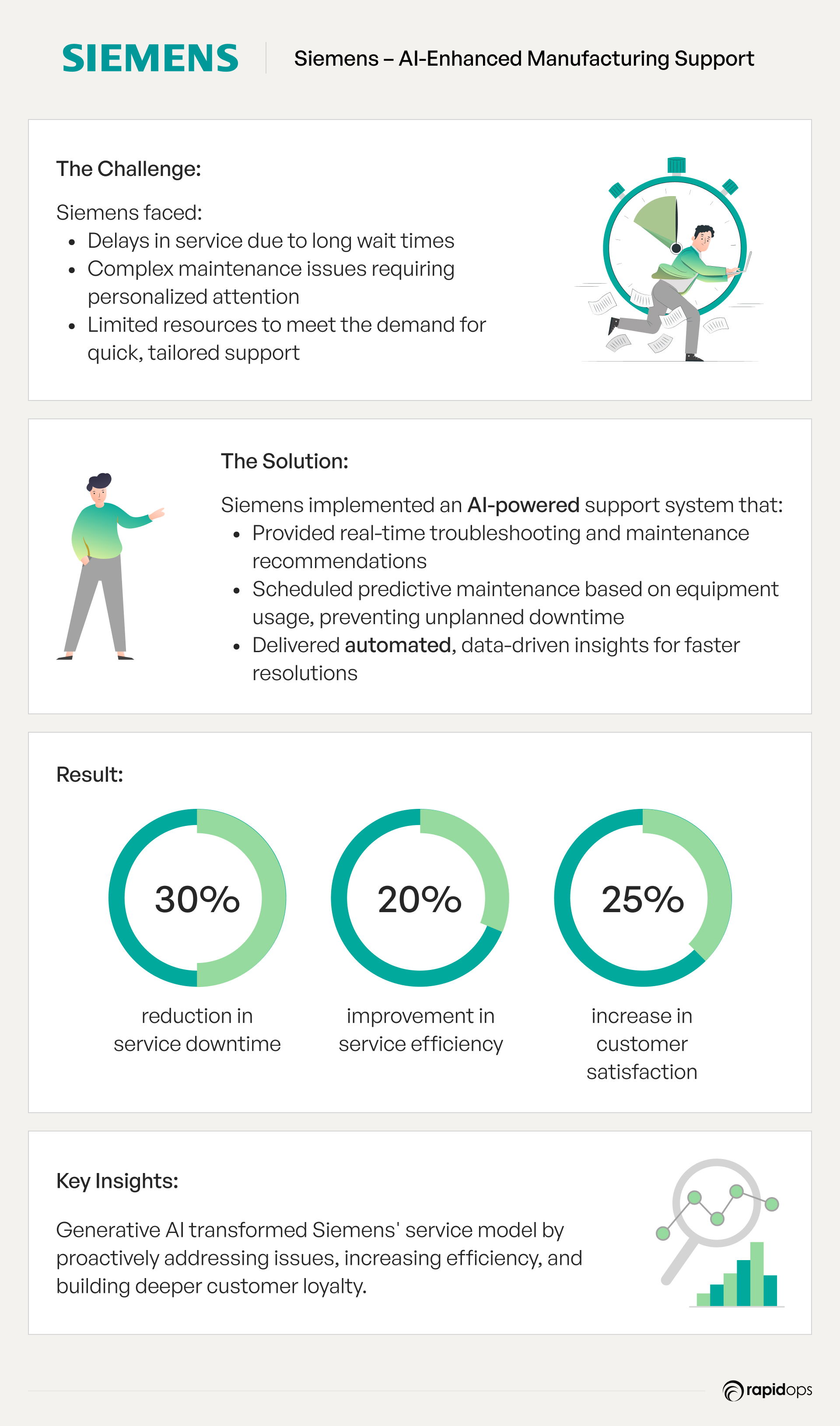
Problem
Siemens’ customer service team faced significant challenges in managing maintenance requests and troubleshooting for its industrial customers. Long wait times for support, particularly during busy periods, led to delays in service and increased customer dissatisfaction. The complexity of maintenance issues required tailored support, but the company lacked the resources to deliver personalized, timely solutions consistently.
Solution
Siemens turned to Generative AI to streamline their support system. The company implemented an AI-powered support portal that provided real-time troubleshooting and maintenance recommendations based on customer purchase history and equipment performance data. The system automatically scheduled predictive maintenance for products based on usage patterns, helping avoid unexpected breakdowns and reduce downtime.
Outcome
- 30% Reduction in Service Downtime: Predictive maintenance scheduling improved equipment uptime by minimizing unplanned outages.
- 20% Improvement in Service Efficiency: AI-driven troubleshooting helped service agents resolve issues faster, leading to quicker customer resolutions.
- 25% Increase in Customer Satisfaction: Data-driven, real-time support led to higher satisfaction and stronger customer loyalty.
Key Takeaways
- Predictive Maintenance: AI reduces downtime by predicting maintenance needs.
- Personalized Service: AI tailors' solution, strengthening customer relationships.
- Operational Efficiency: Automating tasks boosts service efficiency and lets teams focus on complex issues.
Future Trends: What’s Next for Generative AI in Customer Service?
Proactive AI Capabilities
Generative AI is shifting from a reactive tool to a proactive service solution, empowering businesses to address potential issues before they escalate. By analyzing real-time data and predicting disruptions, AI can autonomously resolve challenges, creating a frictionless customer experience.
This proactive approach reduces service delays, enhances customer satisfaction, and strengthens loyalty. As AI evolves, its predictive capabilities will set a new benchmark for seamless and anticipatory customer service.
Voice-Activated AI
Voice-activated AI is rapidly advancing, enabling more sophisticated and efficient customer interactions. Through enhanced natural language processing and speech recognition, generative AI is not only improving service speed but also offering hands-free, accessible, and inclusive customer support. This innovation is a key differentiator, expanding service accessibility and enhancing overall convenience, critical factors for customer retention and satisfaction.
Predictive Customer Insights
Generative AI is redefining personalization by leveraging predictive analytics to anticipate customer needs. By analyzing behavioral patterns, AI can deliver tailored solutions and product recommendations in real time, driving greater engagement and loyalty. This data-driven foresight allows businesses to exceed customer expectations consistently, deepen relationships, and unlock long-term value through enhanced customer lifetime value (CLV).
Seamless AI-Human Collaboration
Future customer service models will integrate Generative AI with human expertise, creating a hybrid approach that combines the efficiency of automation with the empathy of human agents.
While AI handles routine inquiries, it provides agents with real-time insights, enabling them to focus on complex or emotionally charged issues. This collaboration optimizes operational efficiency while preserving the human touch, enhancing the overall service experience and improving outcomes.
These trends show how generative AI is not just a tool for automation but a strategic enabler of growth, customer satisfaction, and market leadership. Embracing these innovations will position businesses to stay ahead of evolving customer expectations and continuously improve their service offerings.
From Hurdles to Growth: Leveraging Generative AI for a Competitive Edge
Generative AI holds immense potential to revolutionize customer service, but the path to success is not without its hurdles. As leaders, you face the challenge of integrating cutting-edge technology into your existing systems while ensuring it delivers measurable results. Whether it’s meeting heightened customer expectations, navigating data privacy concerns, or achieving real ROI, these complexities can be overwhelming.
At Rapidops, we’ve spent over 15 years working alongside decision-makers like you, turning these challenges into opportunities. We understand the intricacies of your business and the unique hurdles you face. That’s why our approach to implementing Generative AI is personalized, designed to seamlessly align with your goals and deliver tangible value. From improving scalability to enhancing personalization, we help you unlock the full potential of AI while ensuring it’s easy to integrate and manage.
Achieving your vision of a more efficient, connected, and customer-focused future is within reach. Book a free consultation call today to explore how Generative AI can support your business’s growth and uncover the right strategy tailored to your needs.

Rahul Chaudhary
Content Writer
With 5 years of experience in AI, software, and digital transformation, I’m passionate about making complex concepts easy to understand and apply. I create content that speaks to business leaders, offering practical, data-driven solutions that help you tackle real challenges and make informed decisions that drive growth.
What’s Inside
- What is Generative AI, and Why Does It Matter?
- How Generative AI Transforms Customer Service
- What Are the Benefits of Generative AI for Customer Service?
- What Technologies Are Behind Generative AI in Customer Service?
- How Is Generative AI Driving Success in Real-World Customer Service?
- Future Trends: What’s Next for Generative AI in Customer Service?
- From Hurdles to Growth: Leveraging Generative AI for a Competitive Edge

Let’s build the next big thing!
Share your ideas and vision with us to explore your digital opportunities
Similar Stories
- AI
- 4 Mins
- September 2022

- AI
- 9 Mins
- January 2023


Receive articles like this in your mailbox
Sign up to get weekly insights & inspiration in your inbox.

